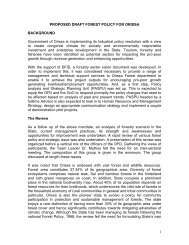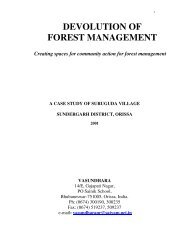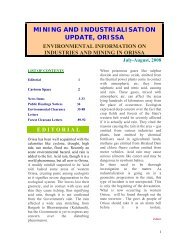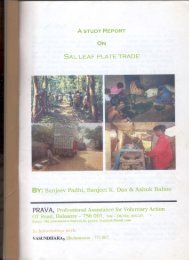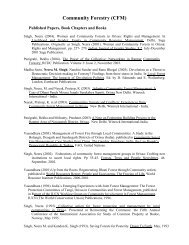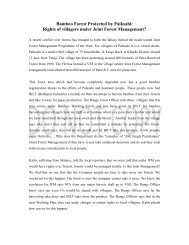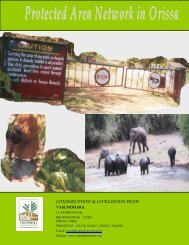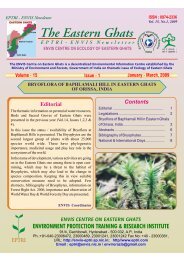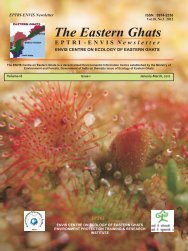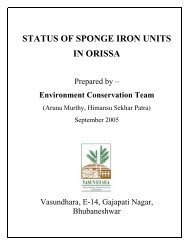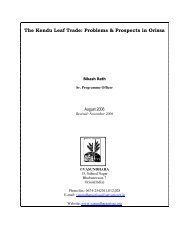Bamboo in Orissa: Trade and Livelihood Perspective - Vasundhara
Bamboo in Orissa: Trade and Livelihood Perspective - Vasundhara
Bamboo in Orissa: Trade and Livelihood Perspective - Vasundhara
You also want an ePaper? Increase the reach of your titles
YUMPU automatically turns print PDFs into web optimized ePapers that Google loves.
All rights reserved by VASUNDHARA(www.vasundharaorissa.org). For any clarification, contact author at sunlit1968@yahoo.co.<strong>in</strong><br />
A Supplement on Cane<br />
Cane 41 (Calamus tenius), otherwise known as rattan, was the only raw material which many<br />
bamboo artisans used to process <strong>in</strong> addition to bamboo. Cane products are comparatively<br />
much more durable <strong>and</strong> sophisticated than bamboo products, <strong>and</strong> are hence costlier <strong>and</strong><br />
considered as either luxury items(like furniture) or sacred(like the mana).<br />
The recorded production of cane <strong>in</strong> 1999-2000 was 1399 pieces valued at 0.003 lakh<br />
rupees(i.e., Rs.3000), as estimated by the Statistical Section of the Office of the PCCF,<br />
<strong>Orissa</strong>. This however does not seem to have <strong>in</strong>cluded production from private l<strong>and</strong>s.<br />
Cane was not a specified forest produce <strong>in</strong> the state as per the Forest Produce(Control <strong>and</strong><br />
<strong>Trade</strong>) Act,1981. It was leased out by the Forest Department. In March 2000, the govt<br />
placed cane under the category of lease-barred items which can be commercially harvested<br />
by govt agencies(like Forest Department, Tribal Development Cooperative Corporation,<br />
etc.) only provided that susta<strong>in</strong>ability is ensured. This is probably because of the fact that<br />
wild occurrence of cane <strong>in</strong> the govt forests has become very limited either due to<br />
unsusta<strong>in</strong>able exploitation, or the super cyclone of 1999. As per an assessment of 1999, the<br />
potentiality of cane <strong>in</strong> the state was as under:<br />
Forest Division Potentiality <strong>in</strong> numbers<br />
Athagarh 76800<br />
Dhenkanal 20000<br />
Balliguda 15000<br />
Ghumsur South 33280<br />
Nayagarh 39680<br />
Puri 62000<br />
Parlakhemundi 800 bundles()<br />
(Courtesy: Statistical Section, PCCF’s Office)<br />
In isolated areas like the Konark-Balukh<strong>and</strong> sanctuary, cane is reportedly abundant; but<br />
there is a ban on its collection (like other NTFPs <strong>and</strong> timber) from the Protected Areas,<br />
<strong>and</strong> outside PAs, leases for commercial exploitation are not to be normally allowed <strong>in</strong> the<br />
govt forests.<br />
The above table <strong>in</strong>dicates a potentiality of more or less 3 lakh pieces. In 1989-90, the<br />
recorded production of cane was 3024000(Statistical Branch: PCCF’s Office, <strong>Orissa</strong><br />
Forests 1993), i.e., about 10 times of this presumed potentiality. Between 1992-93 <strong>and</strong><br />
1994-95, the average annual production was 118847 pieces(<strong>Orissa</strong> Forest 1999, p.32).<br />
However, by 1999-2000, it was reduced by more than 99%(as compared to the production<br />
of 1989-90).<br />
41 When used to imply to a species/plant, as here, cane is the source of the raw material. On the other h<strong>and</strong>,<br />
often the term is used to refer to the th<strong>in</strong> strips extracted from bamboo-, rattan- or other such culms/stems.<br />
94



